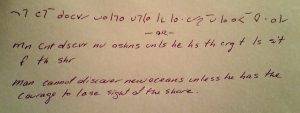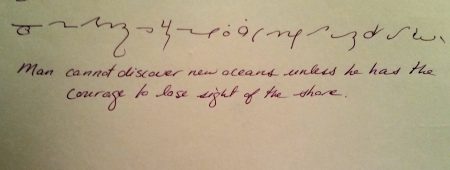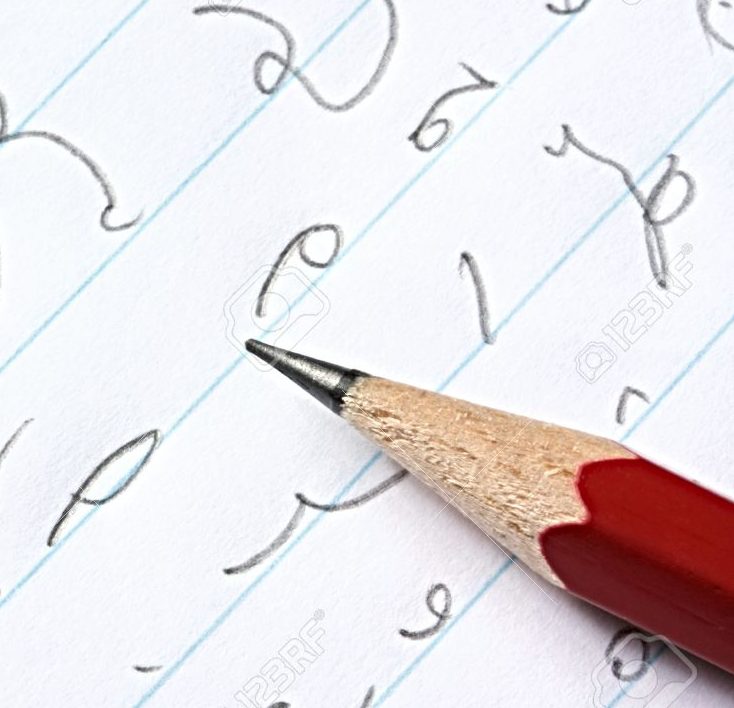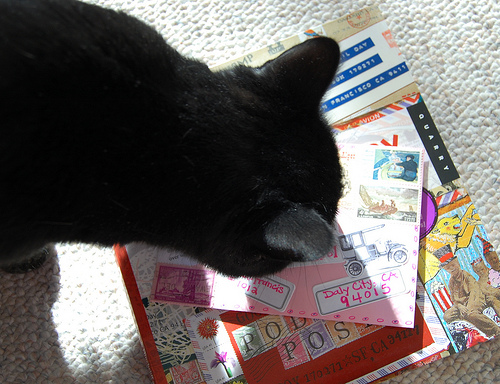Get Your Story in Hand Using Shorthand
Today’s guest post is by Tawnya Showalter.
If you’re a journalist, you may already be acquainted with shorthand. It’s a high-speed method of recording interviews or taking notes, using a simpler set of characters in place of the alphabet.
But shorthand isn’t just for journalists and college students anymore—it’s for authors too.
Writing your first draft—or sketching out a scene—in shorthand can significantly impact the structure of your novel. It helps shore up common pitfalls associated with first drafts, making your editing process a breeze.
Balderdash. Utter nonsense, you say. How can writing quicker really make such a difference?
Well, dear naysayer, have you heard the phrase “Necessity is the mother of invention?” Concentration is a huge problem for me. I see a squirrel, my thought-train derails. I was searching for a way to get my hands to keep up with my thought-train, hoping to minimize the hindrance of the many interludes, and stumbled upon shorthand. Since using it, it’s become quite the eye-opener, helping more than just my word count!
How Shorthand Helps
- It’s efficient and super quick—take that NaNoWriMo!—allowing you to write around two-hundred words per minute. One notebook held an entire first draft of my novel and the beginning of the second. But I’m not selling this idea on the value of saving paper.
- The flow of your book will become more natural since there will be far fewer pauses during the act of writing.
- You’ll find fewer holes in the foundation of your story, caused by things you’ve forgotten during breaks or writer’s block.
- Once you set your creativity free, it’ll grow in strength. Plot conflicts become easier to solve.
- Repeated words and phrases grasp your attention more often.
- Your story acts will become more pronounced as you proceed more like a vocal storyteller.
- Your characters, even secondary ones, will develop more fully, since you’ll be spending more uninterrupted story time with them.
- Writing at a faster pace will speed up the events in your novel, creating a natural page-turner.
Shorthand isn’t some magic juju. It doesn’t rewrite your work while you’re sleeping. It simply reprograms the way you write and the way you think while you write.
Once you become proficient in one of the many versions of shorthand, you’re writing with such speed that the act of writing is gone. Out of the way. There’s no pause in thought while your hands catch up. It’s automatic, and all that remains is your imagination telling yourself the story.
Here’s a quick exercise I can share with you to illustrate the effects of shorthand if you’re not quite ready to invest several hours into learning it.
- Get a clean notebook and a pen.
- Eliminate all noise—TV, radio, washing machine, etc.
- Get comfy. Find your happy place, wherever you can be uninterrupted for a few minutes.
- In the notebook, write a short sentence without picking up your pen. One word should flow uninterrupted right into the next. It should be sloppy! Now write it again, only faster. It’ll be difficult to read, but that’s okay for this exercise. You need to be on the cusp of legibility and pretend-writing. If you feel the urge to leave off the ends of words to get to the next and forgo the dotting of the i’s and the crossing of the t’s, you’re on the right track.
- After you’ve got a handle on what your pen is supposed to feel like, close your eyes and write a paragraph about anything at all. Don’t concentrate on the pen; it should just be flowing. The writing should be messy and spilling through the lines and rife with misspellings to properly illustrate the feel of shorthand.
- Get a fresh sheet and repeat the process, but write something longer. Pretend you’re writing the first page of a new novel. Use that imagination, and keep the thought flowing. Your pen should be moving more quickly now.
Now examine what happened while you were scribbling all over that sheet with your eyes closed. In what ways did it feel different to write this way? Is your story more imaginative or descriptive than your normal writing? Is the flow better? Did the ideas come more readily after a few minutes into the exercise? Did more get written than if you’d have used longhand? Were you eager to keep going once you wrote the first page? Did your concentration seem to intensify?
“Holy smokes, you’re right!” says the naysayer. “The entire act of writing did feel altogether different . . . and I kinda liked it.”
Happy to hear you say so. Once you become more practiced, your inner narrator will be unchained, free to go as fast as needed to tell your story. In essence, your first draft will in many ways become more solid, simply by removing the middleman—your hands.
Some Examples of Shorthand
Let’s examine some samples of shorthand in case you’re thinking of learning this. I’m sticking to the most popular versions because we’ll be here all day and night if I don’t.
PITMAN SHORTHAND: Created by Sir Isaac Pitman and first published in 1837. The Pitman method is what you call “phonetic” because a series of symbols dedicated to the sounds of speech replace the twenty-six-letter alphabet. In the words elephant, epiphany, and fish, the F sound is written with the same symbol.
Vowel sounds are often omitted in Pitman Shorthand; however, there is a separate set of symbols for vowel sounds that’s quite useful for beginners or if someone else needs to read what you’ve written.
In the sample below, I’ve written a short paragraph in Pitman Shorthand. Take note how much less space shorthand uses. And for the love of all that is holy, forgive my messy scrawl. I get in a bit of a hurry when writing whole words these days.

GREGG SHORTHAND: Created by John Robert Gregg in 1888, this version is also phonetic. The symbols are more elegant and seem more like handwriting, making the transition to shorthand less jarring. Take the sample below:

TEELINE SHORTHAND: Developed in 1968 by James Hill, the Teeline version is the easiest form of shorthand to learn and the version that I prefer. Rules fall to the wayside, and the Teeline version is by far the most customizable.
It uses simplified symbols or our twenty-six-letter alphabet, omits most vowels, utilizes abbreviations, and though it isn’t considered phonetic, sometimes phonetic rules are adapted in order to further streamline the writing.
An entire draft written in shorthand can look like an alien language, but even a beginner can recognize certain words in the second Teeline sample below.

If you’re still on the fence about trying shorthand, let me tell you about one more form of that you’re already using. Yes, you read that right; you already know some shorthand. I’m talking about texting!
Now you know where I’m going. Lol, smh, rofl, fyi, btw, brb, jk, omg. The list goes on. Abbreviating common phrases is shorthand.
And, suddenly, the prospect of learning shorthand isn’t quite as daunting as before. The basic Teeline alphabet can be memorized in about twenty minutes.
Now, it takes a few weeks of using it to really start to feel the effect of how shorthand can help, but your first draft will be glad you didn’t give up.
 Tawnya Showalter—AKA Writing Woes—is working on her debut YA novel. At “The Forest,” she is a mechanic, electrician, carpenter, operator, and sawyer. Tawnya offers her assistance and tips to other budding authors at her website. You can connect with her on Twitter.
Tawnya Showalter—AKA Writing Woes—is working on her debut YA novel. At “The Forest,” she is a mechanic, electrician, carpenter, operator, and sawyer. Tawnya offers her assistance and tips to other budding authors at her website. You can connect with her on Twitter.












I haven’t ever tried short hand in this way, but simple-style writing has helped me lay out two 1st drafts within a handful of months.
This is saying a LOT about what this method does for me. I have a minimum of 15 stories on my laptop, all unfinished, melding together because I restarted several after I got lost on them. They all lagged and lulled and I gave up.
Then I found an app that helps plot stories! After a good month of plotting and getting scenes mapped out, I wrote in 5th grade language. He said, she said, we did, I was, she huffed…
AND GOT TWO 1st DRAFTS DONE!!!
Now, the editing process….HAHA!
Thanks for this.
It shows me that what I’ve done is not crazy! lol
I meant to say, one first draft was 39 printed pages.
I’m excited to look into these shorthand methods, if it speeds it up more, even better!
Thanks girls.
Hi Kelly! Glad you’ve found some use in this post! Great minds think alike! Best of luck on getting those other firsts drafts done, sounds like you’ve got a great handle on things now. Call me strange, but I actually look forward to the editing process. It’s very much like getting to color the image after sketching it. Thanks for reading!
Some comments about shorthand:
1. Students of “Pitman 2000” or “Gregg Shorthand Diamond Jubilee Series” obtain writing speeds of about 150 Words per Minute (WPM). These were designed for dictation in the office environment. Court reporting versions of Pitman and Gregg have writing speeds over 225 WPM.
2. Teeline has a writing speed of about 80 to 100 WPM.
3. Yes, Teeline is easier to learn than Pitman and Gregg but Teeline has a reduced writing speed.
4. While Pitman and Gregg have comparable writing speeds, Gregg Shorthand is easier to learn.
5. I recommend the reader look into EasyScript that can be used when hand writing or typing.
I believe the best shorthand for the average person is Gregg Shorthand Diamond Jubilee Series.
What to know more about shorthand, buy my book: “To Labor Less and Accomplish More Part 1: A Brief History of English Shorthand” by Kenneth Wick
Excellent information, Ken! I do believe I’ll look into those other types of shorthand you mentioned above. Thank you so much for reading the post!
I am actually doing this. Shorthand has always fascinated me, and when my wrists both began to display some sort of issues, I turned to shorthand in order to get my thoughts down. The learning curve can be a little steep, but I found I enjoyed it enough to continue. (And the looks of pure puzzlement on the face of a non-shorthand writer when they see a page of my story? Priceless.) Though my wrists healed, thank God, I have gone on with the shorthand and intend to keep it up. (I write Gregg Simplified), and have found ways to weave the art of shorthand into my story–go figure!